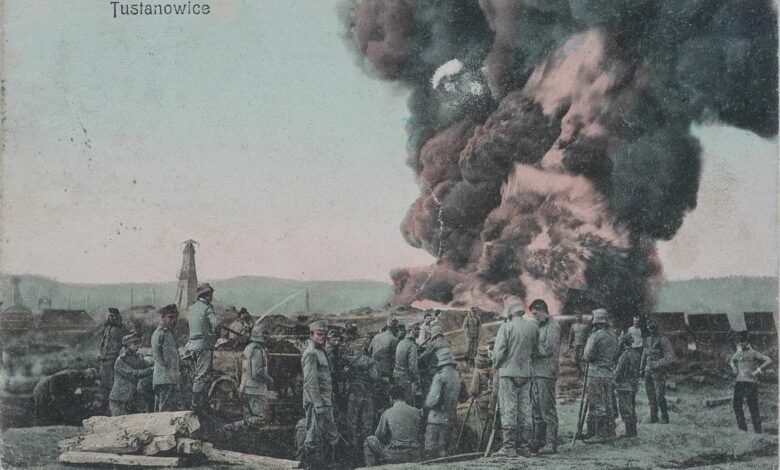
“Galician Vesuvius” near Drohobych in the Lviv region: more than a century ago, one of the largest disasters in world oil production happened here, which we all forgot about…
On this more than a century old postcard, you do not see the First World War and not even an artillery explosion. And that thick black smoke in the photo, which rises hundreds of meters into the sky – this is how Galician oil was burning in the vicinity of Boryslav in the summer of 1908. And Europe has not seen such a force of fire at an oil well either before or after this tragedy.
And it all started quite prosaically: one fine morning at the beginning of 1908, two representatives of the Berlin company “Brown and Berman” visited the village of Tustanovichi near Boryslav, looking for villagers who would allow an oil well to be drilled on their land. Many refused, but Mykhailo Babyak agreed and signed papers according to which if oil is found on his land, he will receive a certain percentage of the profit. And the well laid on Mykhailo Babyak’s bypass was named quite pretentiously: “Oil City”.
After that, the company “Holland Oil Syndicate” took up the matter and, having brought special equipment, began to drill the land in the bypass of the already mentioned Mykhailo Babyak. They drilled in that place for a few weeks and lo… It was on June 13, 1908, somewhere in the afternoon, that the well seemed to sink at the mark more than a kilometer deep (1016 meters).
Within a minute, a fountain of crude oil shot up to the sky with an unprecedented force from the hole drilled in the ground, which immediately reached a height of two hundred meters. At the same time, the underground rumble began to intensify, and along with the oil, gas was released. Moreover, with each hour, this well pushed larger and larger volumes of oil to the surface. Judge for yourself: in just one day, more than three thousand (!) tons of oil and 900 thousand cubic meters of gas flew out of this well under terrible pressure. I ask you to imagine that three thousand tons of oil is – according to Lviv geologist Vasyl Dyakiv – a long-distance train with 50 modern tanks, each of which contains 60 tons of oil.
No attempts to somehow “plug that hole in the ground” led to anything. And with every hour, more and more oil began to pour out into the surrounding area in a radius of more than a kilometer…. Seeing what was happening, the peasant Mykhailo Babyak, who gave his plot of land for the drilling of the Oil City well, fell into extreme despair and hanged himself.
In those days, a correspondent of the Petroleum publication left a description of what was going on in Tustanovichi at the well: “…you could hear a strong hum and roar of oil being pushed out of the ground.” Only four days later – on June 17, it was possible to direct the oil flows to the hastily dug reservoirs around which dams were built.
Maybe this whole story would have ended happily, if only
Imagine: two weeks later – on the fourth of July, an unprecedented storm with hail appeared over the Tustanovychys, and lightning struck that well “Oil City” at 2:30 p.m.! The explosion and fire on it was such that it was seen even from a distance of fifty kilometers, and the burning fountain of oil continued to reach a height of two hundred meters. And then the most terrible thing began: the fire spread to the nearby wells and collectors with oil, which were dug into the ground. So, everything caught fire…
Then the imperial court in Vienna urgently sent troops to Tustanovych to at least somehow put out the fire here. The first to arrive were the troops from Przemyśl and 150 sappers, who already at one o’clock in the morning began to build a huge embankment around it. At the same time, the Austro-Hungarian Empire announced an international competition for the best firefighting project in Tustanovichi, which received more than one and a half hundred proposals from England, Germany, France, Austria-Hungary and Russia. However, even after that, the notorious Oil City well burned for another three weeks and was extinguished only on August 15, 1908. So the fire lasted 42 days. The incident at “Oil City” was compared to the eruption of Mount Vesuvius near Naples, which occurred two years earlier – in April 1906.
On the one hand, for the local Boryslav peasants, work on oil extraction made it possible to escape from the ubiquitous poverty, and for some it gave the opportunity to “go abroad” and seek their happiness across the ocean. It also happened that, until recently, a poor peasant, after getting a job at one of the wells in Tustanovichi, could afford to roll cigarettes from 100-crown banknotes for some time. And in a couple of years, the same peasant could already be seen with an outstretched hand near the church…
Imagine: in 1909, oil wells in Boryslav produced 4% of the world’s oil production. Only the USA and Russia produced more oil at that time. That is, Galicia in those years was in third place in the world in terms of oil production.
Do you think that this tragedy with the well “Oil City” taught the local authorities or even entrepreneurs something? Not much! Because the continuous development of that well lasted until 1947. And it was finally liquidated only in 1952…

